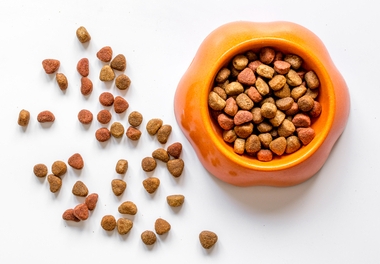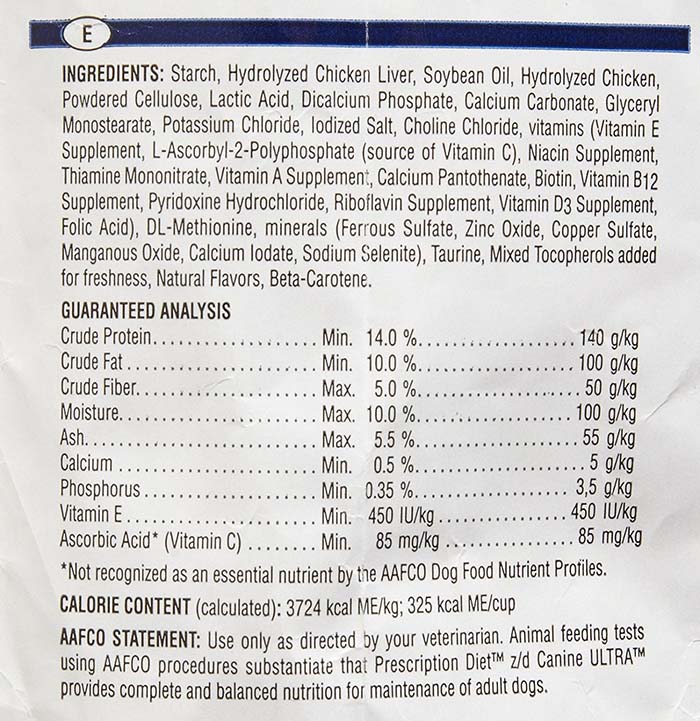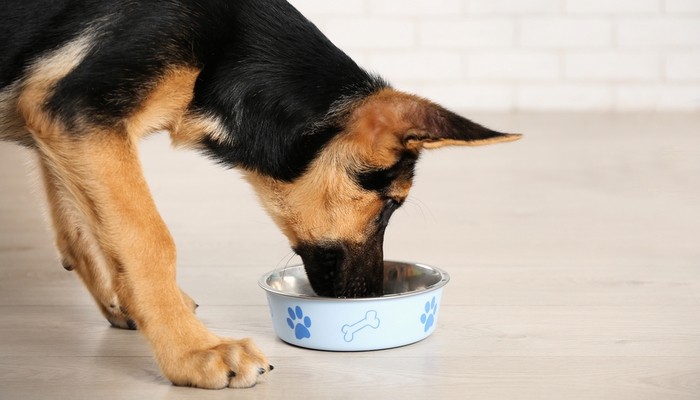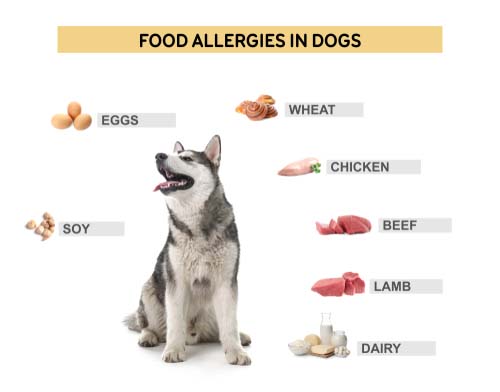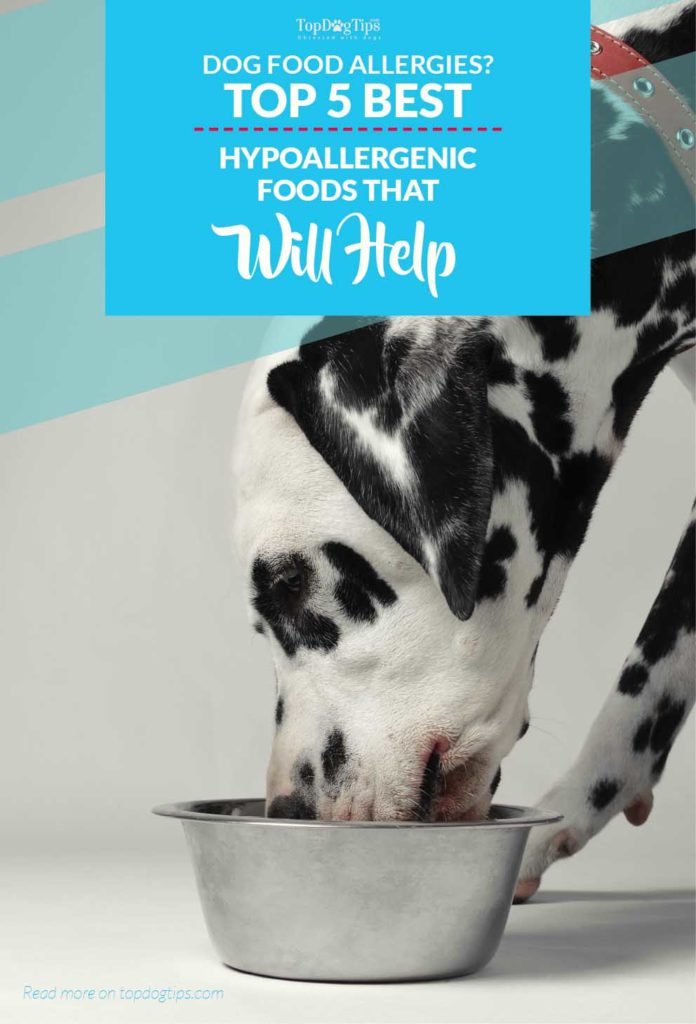
KEY TAKEAWAYS:
– While there are no conclusive scientific explanation why and how dogs get allergies, there are enough anecdotes as to how some triggers, including certain food, cause allergic reactions.
– Allergy testing and/or elimination trial are still the most common and effective ways to know what causes a dog's allergic reaction.
– Vets may prescribe hypoallergneic dog food, sometimes labeled as limited-ingredient diet, in conjunction with the elimination diet. They are food wilth minimal ingredients, often of novel protein sources and mixed with carbohydrates like vegetables.
– Not all commercially-available dog food labeled as “hypoallergenic” is truly one; it's important to scrutinize the ingredients list and check for 10 ingredients or less, with a novel protein source.
– The best ingredient you should look out for when buying a hypoallergenic dog food is “hydrolyzed protein.”
Table of Contents
- Hypoallergenic Dog Food 101
- Efficacy of Hypoallergenic Dog Food: Do They Work?
- Buyer's Guide: Which Dog Foods are Really Hypoallergenic?
- Top 5 Best Hypoallergenic Dog Food Brands
- Hypoallergenic Dog Treats
- What are the Alternatives to Hypoallergenic Diets?
- What to Expect When Switching to Allergy Diets
- Brief Discussion on Food Allergies in Dogs
- FAQs about Hypoallergenic Dog Foods
- Hypoallergenic Dog Food: Before You Go…
If your dog suffers from itchy skin or digestive problems, your veterinarian may have suggested a “diet trial” or “elimination diet” using hypoallergenic dog food as the most effective solution (1).
Many people are familiar with other products labeled “hypoallergenic,” such as cosmetics, but we rarely see foods labeled as such.
In my practice, I often encounter owners who look to switch their dogs to a hypoallergenic diet due to various issues.
But what exactly is a hypoallergenic dog food? Will it work for your dog?
In this article, we will comprehensively tackle everything you need to know about hypoallergenic dog food.
For faster navigation, I recommend you use our jump-to links below:
Jump to each section:
- What is hypoallergenic dog food?
- Do hypoallergenic dog foods work?
- How to shop for hypoallergenic dog food?
- Best hypoallergenic foods for dogs
- Hypoallergenic dog treats
- What are the alternatives to hypoallergenic diets?
- What to expect when shifting to allergy diets?
- A brief discussion about food allergies in dogs
- Questions other pet parents ask
Top 5 Best Hypoallergenic Dog Foods Reviewed In This Guide:
| Preview | Product | Rating | |
|---|---|---|---|

|
Ps for Dogs 100% Hypoallergenic Dog Food - No More... | 684 Reviews | Check Price |

|
Wellness Natural Pet Food Wellness Simple Natural... | 2,468 Reviews | Check Price |

|
Purina Pro Plan Sensitive Skin and Stomach Dog... | 23,135 Reviews | Check Price |

|
Addiction Outback Kangaroo Feast Raw Alternative... | Check Price | |

|
Purina Pro Plan Veterinary Diets HA Hydrolyzed... | 181 Reviews | Check Price |
Hypoallergenic Dog Food 101
It's common today for pet food companies to release a type of hypoallergenic dog food alongside their line of regular dog foods.
But not everything labeled “hypoallergenic” will work for every dog or every health problem it may be bought for.
In the most basic sense, hypoallergenic means below allergenic.
This means that the structure of the potential allergen in that specific dog food recipe is so small that your dog's immune system can’t detect it.
This is done by breaking down or hydrolyzing the proteins into very small amino acids that still provide a complete array of essential nutrients our dogs' bodies require.
The Science Behind Hydrolyzed Proteins

According to Dr. Joe Bartges, a board-certified veterinary internist and nutritionist, proteins are hydrolyzed for hypoallergenic dog foods because it disrupts protein structure in the food formula.
This process removes any existing allergenic epitopes and allergens, preventing the dog's body from recognizing that protein.
This had to be done because studies have shown that most dogs and cats are usually allergic to protein.
Proteins with molecular weights of over 18,000 daltons are well-known to be the most antigenic.
Thus, modification of proteins to compounds having lower molecular weight may be of benefit.
When the average weight of the protein molecule is reduced to less than 18,000 daltons, that protein source becomes hypoallergenic.
But even with the adjustments, all hypoallergenic dog foods are well-balanced and nutritionally complete for dogs to consume.
Furthermore, consuming protein hydrolysates results in a quicker absorption of amino acids compared to whole proteins' absorption rate.
Efficacy of Hypoallergenic Dog Food: Do They Work?
Most of the time, hypoallergenic diets work.
However, it's not a sure-proof way or the fastest way to understand Fido's food allergy.
But hypoallergenic dog food, plus doing an elimination diet and gastroscopic food sensitivity testing (GFST), are still the best approaches we have to determine the culprit of your dog's sensitivity. (2, 3, 4).
They're especially good for very allergic dogs that do not respond to other types of therapeutic dog food diets, although that's not always the case.
Dogs and cats that benefit most from hypoallergenic dog food typically suffer from the following:
- Food allergies
- Atopic Dermatitis (10% of dogs with atopic dermatitis will have food allergy)
- Irritable Bowel Disease (IBD)
- Lymphangiectasia
You should also be aware that simply switching your dog or cat to a hypoallergenic dog food diet will not change their condition overnight.
Studies have analyzed (5) the length of using hypoallergenic dog food and found that while 3 weeks are sometimes enough, keeping the dog on the diet for at least 10 weeks is the most effective.
Also, other issues that contribute to your pet’s allergic discomfort, such as an active skin infection, need to be addressed before a complete diet change (6).
ASK A VET: How to Put an Overweight Dog on a Diet?
Buyer's Guide: Which Dog Foods are Really Hypoallergenic?
The term “hypoallergenic” has no legal definition regarding pet foods.
Many dog food brands may have the word “hypoallergenic” on their packages but do not include hydrolyzed ingredients.
A food is not hypoallergenic if it does not include the term “hydrolyzed” on the ingredients label.
Unfortunately, dog food labeling guidelines are not as strict as labeling requirements for human foods. One of our resident vets, Dr. Dana Brown, has discussed this in the Understanding Dog Food article.
Due to loose pet food regulations, companies find loopholes to mislabel their products, and it's still legal for them to do so.
For example, many bloggers have written that Orijen-brand dog foods are “hypoallergenic.”
This is not true – Orijen adult formula contains more than one protein source, all common allergens – eggs, poultry, and fish.
A food is also not hypoallergenic if it contains more than one protein source.
While Orijen dog food is a great brand, it won't work for dogs with allergies.
A dog food is considered hypoallergenic when it contains:
- A limited (minimal) number of ingredients (under 10 ingredients)
- High-quality Novel ingredient(s) that a sensitive stomach dog is much less likely to be allergic to, but not always guaranteed.
- Least offending ingredients (less likely to cause allergic reactions)
However, do not instantly fall for brands labeling their dog food as “limited-ingredient.”
They only opt for this terminology to make them more appealing to a wider range of consumers since not all dogs with food sensitivities are allergic but may have other issues.
Limited-ingredient diets are not necessarily hypoallergenic.
Why? Because non-prescription LID foods that you can buy over the counter might still be contaminated with allergens.
In a 2017 study, 12 commercial dog food products labeled suitable for elimination diet were tested for animal origin DNA using PCR testing.
The DNA included chicken, turkey, beef, mutton, and pork. In 9 of 10 over-the-counter (non-prescription) limited-ingredient dog food diets, DNA of one or more animal species other than what was declared on the label was found.
The most common “contaminants” were beef and pork.
Two prescription hydrolyzed diets tested in the study only contained DNA of the animal declared on the label.
Do you see now why we always advise you to talk to your vet before switching Fido's diet to a different one?
As a veterinarian myself for many years now, it's my responsibility to keep pet owners informed about the products they buy or use for their dogs, especially with so many controversies in the pet food market these days.
Your best bet to get truly hypoallergenic dog food is by getting prescription dog food diets from your vet. However, prescription diets come with a hefty cost.
But don't worry; there are still over-the-counter brands with the same or similar ingredient composition.
You just have to be careful about choosing one.
RELATED: 7 Tips On How To Feed Dogs To Deal With and Prevent Allergies
Top 5 Best Hypoallergenic Dog Food Brands
1P.S. 100% Hypoallergenic Food for Dogs
-
- Find it on Amazon
- Unavailable on Chewy
- Price to value: $15.67/lb
 PS for Dogs offers a 100% hypoallergenic dog food that uses a single source for its high-protein content: lamb or turkey.
PS for Dogs offers a 100% hypoallergenic dog food that uses a single source for its high-protein content: lamb or turkey.
All of the ingredients are hypoallergenic, low-glycemic, and grain-free. It's also the most expensive dog food brand out there.
With this specially prepared food, dogs get their required high-protein diet without the ingredients that trigger allergies.
According to many dog owners, this dog food resolved their pets’ issues in just a matter of days after feeding it.
- REDUCES PAW LICKING: Our low...
- SOLVES SKIN ITCHING, REDNESS,...
- GRAIN FREE, HIGH PROTEIN AND...
- SOLVING ALLERGIES IS OUR SOLE...
- Made in New Zealand in Small...
The skin reactions were significantly reduced, and after a few weeks more, the dog's skin visibly cleared up, and the hair even showed signs of growing back.
Because of the limited number of ingredients, P.S. 100% Hypoallergenic Dog Food is great in isolating the cause of allergies.
Optimum health and minimum to zero allergic reactions – nothing could make pet owners happier.
Buyers admit that this product is on the pricey end, but they find great value in it.
They say that they have spent so much more on vet visits and medicines just so they and their dogs can live happy, normal lives.
The right food heals, and that is the reason why this brand is on our top 5 best hypoallergenic dog food list.
PROS:
|
CONS:
|
2Wellness Natural Limited Ingredient Dog Food
- Find it on Amazon

- Find it on Chewy
- Price to value: $2.63/lb
The key is in the ingredients. Fewer ingredients mean fewer components in the food to react to.
This dry dog food from Wellness Natural Pet Food contains only natural components, a single protein source, and no usual allergens like wheat, corn, soy, and gluten.
There are no fillers, meat by-products, eggs, artificial color, or flavor, just high-quality lamb meat and choice carbohydrate sources.
Protein variations include duck, salmon, and turkey. This product is made in the USA and comes in 4.5, 10.5, 24, and 26 pounds.
Pet owners who purchased this product say the simplicity of the ingredients list suited their dogs, even the ones intolerant to most dog food brands.
- LIMITED INGREDIENT ADULT DOG...
- SUITABLE FOR DOGS WITH FOOD...
- SUPPORTS DIGESTIVE HEALTH AND...
- NO CORN, WHEAT, OR SOY: Adult...
- MADE IN USA: Using only the...
Buyers surmise that with just five ingredients to deal with, their pets had fewer bouts of allergy or stomach disturbances, rarely over-ate, and had better stools.
Their coats turned healthier, too, with much-reduced scratching and chewing.
As with all the best hypoallergenic dog food products, there are reviews from buyers who say that this food didn't help their pets.
A few reviewers also noted that this food made their pet ill, but that could have been a drastic diet change.
PROS:
|
CONS:
|
3Purina Pro Plan Focus Sensitive Skin & Stomach
- Find it on Amazon

- Find it on Chewy
- Price to value: $2.3/lb
Probiotics, essential fatty acids, and antioxidants are three nutrients that dogs with sensitive skin and tummy need a good dose of in their daily meal.
Purina Pro Plan has created Focus Sensitive Skin & Stomach Salmon and Rice dry dog food to keep the correct balance of these key nutrients in your dog’s daily food intake.
The product is available in three bag sizes, including a 5-lb bag for those dogs trying this out for the first time or transitioning to this hypoallergenic diet.
The protein source for this best hypoallergenic dog food is premium-grade real salmon, but your dog can also have a lamb variant.
Problematic dog allergies often mean constant visits to the vet, expensive treatment, and an unhappy dog.
Stressed pet owners say they’ve searched for every possible solution to make life easier and more normal for their dogs. Finding this product saved the day for them.
- Oat meal is easily digestible...
- High protein formula, with...
- Fortified with guaranteed live...
- Used to be known as FOCUS...
- Sunflower oil rich in omega-6...
After successfully transitioning to Purina Pro Plan Focus Sensitive Skin & Stomach Salmon & Rice Formula Dry Dog Food, their dogs showed significant improvement and seemed to like the food, which is often the first test on how new dog food is going to work.
Gone were the digestive upsets, skin irritation, and infections that constantly hounded their four-legged companion.
Most dog owners don’t particularly approve of the food’s fishy smell but say that they can live with that as long as their dog enjoys the chow and evidently benefits from it.
Many long-time users of this food have also stated that Purina changed the formula recently, and it upset their pet's digestion.
PROS:
|
CONS:
|
4Outback Kangaroo Feast Hypoallergenic Dog Food
- Find it on Amazon

- Find it on Chewy
- Price to value: $10.9/lb dry matter
If your dog is allergic to the usual protein sources like beef, chicken, fish, or lamb, maybe it’s about time to try a totally new kind of dog food – dehydrated raw kangaroo meat.
The chunky Outback Kangaroo Feast from Addiction Pet Foods is made from raw kangaroo meat that underwent a special dehydration process to preserve its nutrients and flavor and protect it from spoilage.
It also contains apples, carrots, canola oil, papayas, potatoes, spinach, and sunflower seeds.
The company carefully prepared this new alternative to the usual dog fare to meet the nutritional requirements of dogs per AAFCO standards.
Dog owners appreciate the convenience that this product offers.
It has the advantage of being raw but without the hassle of preparing raw food – previously impossible with traditional raw dog food.
- Great price for value: Made...
- Flavorful and nutritious:...
- Convenient and safe...
- With Coconut Oil: Gentle on...
- Can be served in different...
Most dogs have not been exposed to kangaroo meat before, so they’re less likely to have developed allergies to it.
Many buyers of Outback Kangaroo Feast have long used this for their dogs, and they recommend it to people with sensitive dogs.
They say this has resolved previous health issues, and they now have a dog with a lustrous coat, happy disposition, and evidently healthy condition.
While the feed costs more than the above-average best hypoallergenic dog food brands, pet owners can’t stop buying something that has reliably kept expensive bills and wearying therapy at bay.
Some reviewers stated that their dogs would not eat this food, and they questioned the amount of meat in it.
Unlike other similar types of dog food, they say that it is all powder, and there are no chunks of dehydrated meat.
PROS:
|
CONS:
|
5Purina Hydrolyzed Dog Food
- Find it on Amazon

- Find it on Chewy
- Price to value: $7.67/lb
Dogs are naturally meat-eaters, but some dogs are allergic to meat due to genetic factors.
Some develop rashes that lead to intense itching, while others react with an upset stomach when fed with meat.
Purina Veterinary Diets has created this vegetarian food that is designed to meet the dietary requirements of this particular group of canines. The main ingredient of this dry dog food is hydrolyzed soy protein.
This best hypoallergenic dog food is enhanced with vitamins, minerals, and essential fatty acids to ensure proper nutrition and a strong immune system.
Vegetarian food is not for every dog, though. It was formulated as a treatment for dogs with sensitivities to animal protein.
- One (1) 6 lb. Bag - Purina Pro...
- Formula contains hydrolyzed...
- Single carbohydrate source
- Highly digestible to promote...
- High-quality protein
Pet owners say that Purina Veterinary Diets Canine HA Hypoallergenic Vegetarian Dog Food is one of the few food products their sensitive dogs can take without developing adverse reactions.
The vegetable ingredients are definitely easier on their stomachs, as was evident from the firmer stool. The itching has disappeared, and the dogs are noticeably more comfortable.
The dogs love the food, too, and that solves half of the problem. It's difficult to find a poor review of this product, but some buyers claimed that their dog would not eat it.
Others said that their dog's condition showed no improvement when switched to this diet.
PROS:
|
CONS:
|
Runners-up for the Best Hypoallergenic Dog Food
Some other brands of hypoallergenic dog food that are worth mentioning are:
-
- Royal Canin HP Hypoallergenic Dog Food ($5.91/lb) has what we have discussed above—hydrolyzed protein from soy.
This makes it easy to digest and perfect for dogs with food sensitivities. They also have another line of Hypoallergenic dog food with selected protein content.
I also appreciate that Royal Canin has different lines of Hydrolyzed Protein dog food for different health conditions—like this one for urinary health.
-
- Hill's Prescription Diet z/d ($5.5/lb) is another popular hypoallergenic dog food that contains hydrolyzed chicken meat and liver.
This is particularly helpful for dogs that show visible signs of allergy on their skin and hair.
-
- Instinct Limited Ingredient Diet ($3.6/lb) contains only two ingredients —one animal protein and one vegetable source.
It's one of the best limited-ingredient dog food brands due to its simplistic formula, no fillers, grains, or otherwise unknown or suspicious ingredients.
Its easily digestible protein source makes it perfect for most dogs with food allergies and food sensitivities.
-
- CANIDAE Grain Free PURE Land ($53.88/13 oz. can) is well-known for sourcing unique, high-quality ingredients for its dog food formulas.
This one contains lamb as the main source of protein. However, it may not suit every dog with allergies since the number of ingredients is still longer than some other formulas.
-
- Natural Balance L.I.D. Limited Ingredient Food ($3.45) contains a grain-free formula with premium protein and carbohydrate sources.
However, even though Natural Balance is known for its best-limited ingredient dog food formulas, this one still has a comparably higher number of ingredients.
Nevertheless, the recipe is easy to digest.
-
- Rachael Ray Nutrish Just 6 Natural Food ($1.7/lb) has a very similar formula to Canidae's. This hypoallergenic dog food can be a good alternative to the Natural Balance formula (and vice versa).
The recipe is simple, with only six ingredients, added vitamins and minerals, and no by-products or fillers, but it contains grains, ground, and brown rice.
-
- BLUE Basics Limited Ingredient Diet ($2.50/lb) is another one of the best hypoallergenic dog foods due to its low number of ingredients, high protein source, and no grains.
While some BLUE dog foods have been under heat in the past, their limited ingredient formula is still one of the best, but it may not fit every dog with sensitivities.
-
- The Honest Kitchen Hope Dehydrated Minimalist Food ($9.95/lb) is one of the most expensive brands on this list, with human-grade, FDA-approved, and high-quality dog food.
It's one of the best-rated dehydrated foods resembling raw feeding and only contains six quality ingredients.
-
- Merrick Limited Ingredient Diet Grain-Free ($3.28/lb) is a favorite among pet owners looking for high-protein dog food with no grains.
Their LID grain-free formula is available in lamb or salmon, two of the most popular novel protein sources for the hypoallergenic diet.
The recipe, however, may not fit a lot of dogs with food sensitivities and allergies.
-
- NUTRO Limited Ingredient Diet ($4/lb) – although NUTRO's dog foods are generally highly rated five-star brands, they're not known for their limited ingredient formulas or best hypoallergenic dog foods.
This one is mostly an alternative if you can't pick any other limited-ingredient dog food brand.
It contains ten ingredients, no grains, and claims to have eliminated popular food sensitivity ingredients.
All these diets are very similar, so you may often benefit more by simply choosing the cheap hypoallergenic dog food brand from either of these manufacturers.
However, discussing it with your own vet is essential.
If your veterinarian recommends one over the other, it is most likely due to geographical availability and personal clinical experience using the diet with other dogs.
Hypoallergenic Dog Treats
If your dog has now switched to hypoallergenic dog foods, complimentary hydrolyzed protein treats are also available and recommended.
If you feed one particular hydrolyzed diet brand, buy treats from the same company.
For example, if you feed Royal Canin Hydrolyzed Protein PS food, then it's best to select Royal Canin’s hydrolyzed protein hypoallergenic dog treats.
Remember to stick with a hydrolyzed protein – don’t be tempted to switch to something else like venison or salmon, even if the label says it's “hypoallergenic.”
Vet-recommended hypoallergenic dog treats that are commonly available are:
Semi-homemade hypoallergenic Dog Treats
If hypoallergenic dog treats are unavailable or too expensive, you can try making your own.
Top Dog Tips has a large database of homemade dog treat recipes.
You can easily do this by purchasing a complimentary hydrolyzed protein hypoallergenic canned dog food diet.
For example, if you already switched your pooch to hypoallergenic dog foods, and now he eats Hill’s z/d dry, you can purchase a can or a bag of Hill’s z/d formula and make treats out of it.
The process is simple:
Roll out the canned dog food into a thin layer using your hands. Cut out the canned food into shapes of your choice. Stars, small circles, or dog bones.
Using a food dehydrator or an oven at low temperatures (200 F or 93 C), bake the treats on parchment paper for 1 to 2 hours.
Cooking time depends on the size and thickness of the treat.
Check on them every 30 minutes until they are dry and crunchy. Store in a zip-top bag in the refrigerator for up to 2 weeks.
RECIPE: Hypoallergenic Homemade Dog Food
What are the Alternatives to Hypoallergenic Diets?
As I have mentioned above, an elimination diet using hypoallergenic dog food is the most common way to deal with allergies in dogs. But there's an alternative.
For canines with food allergies, veterinarians use one of two types of diets when addressing allergies: the hypoallergenic diet and the novel protein/carbohydrate diet.
The novel protein/carbohydrate diet introduces a single protein source and a single carbohydrate source into the dog's diet.
Ideally, your dog shouldn't have been exposed to these protein and carb sources yet.
These diets commonly include wild meats or fish, such as venison, salmon, lamb, or duck (7).
The carbohydrate sources can include vegetables like sweet potatoes or peas.
Novel protein/carbohydrate diets for dogs are introduced, like the hypoallergenic dog food diet I've outlined above.
Often, they are slightly less expensive than hypoallergenic diets, but they still require veterinary prescriptions.
If your veterinarian recommends a novel protein/carb diet, it may be possible to cook at home for your pet using appropriate homemade dog food recipes that will work for your dog.
If home cooking interests you, definitely ask your vet for a referral to a canine nutritionist.
The nutritionist can formulate a recipe specifically for your pet’s needs.
What to Expect When Switching to Allergy Diets
Your veterinarian will give specific instructions for switching your dog's old diet to his new hypoallergenic feeding regime.
Typically, the switch is made very gradually. This will help prevent any digestive upset for your dog.
Here are a few tips to keep in mind when switching to hypoallergenic dog foods:
1. Purchase new water and dog food bowls for your pet. As the above studies show, old dishes, especially plastic bowls, can hold allergens even if cleaned in a dishwasher.
2. Transition your dog slowly. Start by mixing his old dog food with his new hypoallergenic dog foods for 3-4 days, and then feed only the hypoallergenic diet.
3. Do not give your dog any doggy treats, no bully sticks or bones, no chews, or anything else that could contain non-hypoallergenic ingredients.
4. Do not give your dog any people food for the very same reason.
5. As the above study indicates, it's best to feed your dog the hypoallergenic dog food diet exclusively for at least 6-8 weeks and possibly even 10 weeks.
After the “diet trial” period of 6-10 weeks, you should be able to know if the new hypoallergenic dog food really works or not.
You will need to consult with your vet about signs you may or may not be seeing in your pet, which will potentially point to allergens.
Sometimes, your dog can return to his regular high-quality commercial kibble as long as you avoid certain ingredients.
Other times, you may need to incorporate homemade dog foods.
Occasionally, if the hypoallergenic dog food diet is the only thing that works for your canine, it may need to be a life-long change to avoid any issues.
RELATED: 31 Dog Food and Feeding Myths You Need to Stop Believing
Brief Discussion on Food Allergies in Dogs
By design, the immune system in both dogs and humans is supposed to protect the body from foreign invaders that can hurt it, such as viruses and bacteria.
Allergies in dogs happen when the canine body’s immune system overreacts to a substance that is harmless, falsely labeling it as an “invader.”
For reasons that are still not fully understood by science, in some individuals and canines, the immune system is overly sensitive, and it will react with “allergy symptoms” to certain otherwise harmless substances.
Some of these allergies can be genetically linked in dogs, while others may be due to previous exposure to a certain food item.
Most hypoallergenic dog foods alter their protein because studies have shown that protein is what most dogs and cats are usually allergic to (8).
Several studies also proved (9) that the most common types of foods that dogs are allergic to are beef, dairy products, chicken, and wheat.
Further studies (10) show that dogs can be allergic to even more foods, with beef being on the lower scale:

Typically, it's very difficult to pinpoint exactly what food item the dog may be allergic to.
Only testing and/or an elimination diet can tell you exactly what your dog is allergic to (11).
Food allergies in pets can cause a wide range of problems — from chronic itchy or infected skin to ear infections to GI tract problems and more.
To read more about dog allergies, I recommend you to check out these articles:
- Dog Food Allergies: What They Are and How To Feed Your Dog
- Allergy Meds For Dogs: When Does Your Dog Need Them?
- Most Common Allergies In Dogs
- 7 Tips on How To Feed Dogs to Deal With and Prevent Allergies
FAQs about Hypoallergenic Dog Foods
Why Are Hypoallergenic Dog Food Diets So Expensive?
It's true that when switching to a hypoallergenic dog food, you'll probably have to increase your pet feeding budget.
The most common explanation for this expense increase is that these diets take years, if not decades, to develop and test.
The processing of hypoallergenic dog food requires costs more than manufacturing regular dog food.
For example, Hill’s Science Diet reports that its hypoallergenic food, z/d Ultra, is produced exclusively on its own production line in a separate facility from the rest of its food processing where its other dog foods are made.
They explain that this eliminates cross-contamination of allergens from other production lines.
The separate equipment, maintenance, and personnel add to the overall cost.
Another example is Royal Canin. They use both controlled manufacturing practices and a DNA test for each batch of hypoallergenic food to ensure that there is no “foreign” protein contamination.
The more precautions that a pet food company takes to ensure good quality control and to ensure the food is hypoallergenic, the more expensive it will be.
What breed of dogs are allergic to chicken?
Chicken is a common food allergy for all breeds.
But the breeds that are particularly vulnerable are Golden Retrievers, Labradors, Dalmatians, Boxers, Boston Terriers, German Shepherds, and Cocker Spaniels.
How long does it take for a food allergy to clear up in dogs?
Unfortunately, when dogs have food allergies, symptoms can persist despite having switched your dog's food.
Expect symptoms to stick around for eight weeks or so before being completely gone.
Is hypoallergenic the same as grain-free?
No, hypoallergenic and grain-free are not the same when it comes to dog food.
While some grain-free foods may also be considered hypoallergenic, being grain-free alone does not mean a food is suitable for dogs with food allergies.
Hypoallergenic refers to foods formulated to be less likely to cause allergic reactions in sensitive dogs. It may still include grains or carbohydrates that are easily digestible for dogs, as the focus is on avoiding multiple allergenic ingredients rather than grains alone.
The best hypoallergenic options will use a novel single-protein source and limited additional ingredients to prevent reactions to multiple food sensitivities in allergic dogs.
Hypoallergenic Dog Food: Before You Go…
When your dog has an allergy, the first thing to do is speak with your veterinarian and formulate a plan of action.
As discussed above, an elimination diet using either hypoallergenic dog food or a novel protein/carb diet is the best way toward success.
However, studies have shown (12, 13) that including an increased amount of omega-3s in your dog's diet may help with allergies as well as improve a ton of other health factors (14).
But don't just rely on the “fish oil” that is on the ingredients list.
This fat is very susceptible to processing, so it is likely that there is little to no fish oil, even if the food claims to have it.
The best way to add omega-3s into the dog's diet is to give dog fish oil supplements.
Another thing to consider is probiotics for dogs.
There is no evidence (15) as to how effective probiotics are for dogs with allergies (yet good for their general health), but there are a lot of studies on positive effects for people with allergies (16, 17).
As established above, dogs and humans have a lot in common when it comes to dealing with allergies.
Find a way to add any of these to your dog's diet, whether through supplementation or by adding some fish oil and probiotics into your dog's food.
However, discuss this with your vet beforehand so that you can successfully track the elimination diet.
Have you tried any of these hypoallergenic dog foods? How did your pup react to any of these limited-ingredient dog food brands?
Share your experience in the comments section so more dog owners are aware of any issues!
Related Articles:
- How to Feed Dogs with Food Allergies
- Recipe: Hypoallergenic Homemade Dog Food
- 8 Best Mixed-Breed Hypoallergenic Dogs
Disclosure: We may earn affiliate commissions at no cost to you from the links on this page. This did not affect our assessment of products. Read more here and find full disclosure here.
Want to share this?


